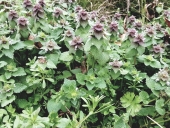
 2
2





 6
6




List of Bryant RedHawk's Epic Soil Series Threads We love visitors, that's why we live in a secluded cabin deep in the woods. "Buzzard's Roost (Asnikiye Heca) Farm." Promoting permaculture to save our planet.
 3
3




If seed is sown untreated in the spring, some species will not germinate until the following spring after wintering over.
 2
2




Invasive plants are Earth's way of insisting we notice her medicines. Stephen Herrod Buhner
Everyone learns what works by learning what doesn't work. Stephen Herrod Buhner
 1
1




“Trees know when we are close by. The chemistry of their roots and the perfumes of their leaves pump out change when we're near...when you feel good after a walk in the woods, it may be that certain species are bribing you”
― Richard Powers, The Overstory




Jeff Pollari wrote: Any recommendations on where to find the best collection of wild flower seeds for variety and quality?
JayGee




growing food and medicine, keeping chickens, heating with wood, learning the land
https://mywildwisconsin.org








Jeff Pollari wrote:Any recommendations on where to find the best collection of wild flower seeds for variety and quality?
Invasive plants are Earth's way of insisting we notice her medicines. Stephen Herrod Buhner
Everyone learns what works by learning what doesn't work. Stephen Herrod Buhner




Bryant RedHawk wrote:How would mother nature spread these seeds? when would she spread them? Those are the prime questions to always ask when dealing with seeds.
Nature doesn't wait usually, if she does then the seeds would remain in their "pods" until the time was right for them to be planted.
Cone flowers are a good example, as are most of the nut trees. The seeds are released in the fall and they overwinter on or in the soil, the next spring they germinate and grow.
Stratification is man's way of doing what nature does automatically, it is an attempt at giving seeds their "winter chill", this can be done artificially (stratification) or naturally (plant in the fall and let winter be the cold storage).
Redhawk

|
Yup, yup, yup. Tiny ad:
Homestead Pastured Poultry course
https://permies.com/wiki/364740/Homestead-Pastured-Poultry
|





